
Wound Dressings Page Menu: 1 2 3 4 5 6 7 8 9 10 11 Next>>
Wound Dressings in the Golden Age of Piracy, Page 9
Bandaging Elements: Splints
"The splints are to be smooth, even, and rounded at the extremities; somewhat less all along than the upper bandaging, and thickest at the part to which the fracture inclines." (Hippocrates, On Surgery, p. 72-3)
Although splints aren't bandages, they are an important part of the bandaging process, especially for fractures and luxations.
Composition
Ambroise Paré gives us quite an extensive explanation, noting splints they were "composed of pastbord [pasteboard - Thin firm boards made from sheets of paper pasted together - like the material on the inside of a hardbound book cover], of thin splinters of wood, of leather, 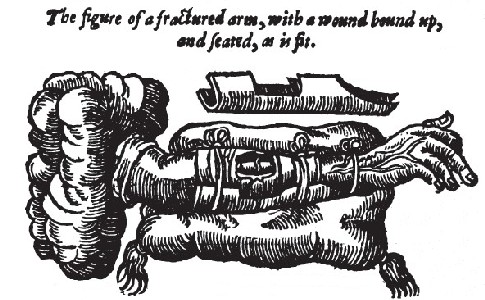
Detail of a pasteboard splint, cut and fitted to the arm, from The Workes of That Famous
Chirurgeon Ambroise Parey, by Ambroise Paré, ,p. 379 (1649)
such as shoo-soals [shoe soles] are made with, of the rinds [bark] of trees, of plates of latin, or lead, and such other like, which have a gentle and yeelding stiffness"1.
Military surgeon Richard Wiseman suggests that "If you think those [splints] of Pastboard not strong enough, you may use Laminæ [thin sheets of], Copper or Tin-Plates lined with soft Linings, to receive the fractured Member, with Loops in the outside, to receive the three Ligatures [cloth ties to hold the plates in place] answerable to those which lie underneath next the Plaister, and they may be fastned and loosened at pleasure, without disturbing the Fracture, in the daily dressing of the Wound."2
In another place, Wiseman includes pasteboards and scabbards sowed inside linen as potential splints, although he warns that, "Scabbards are apt to bow, and so those of the thickest Pastboard, especially if they chance to be wet."3 Another Military surgeon, William Clowes, suggests that the splints be "made of light willow wood, being very plain and smooth and blunt and round at both the ends, well wrapped about and also bolstered with tow"4.
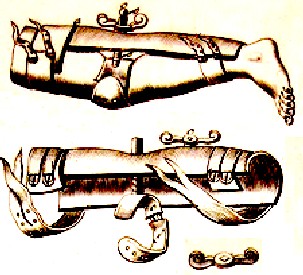
A form of metal splint, from Alle de Medinale en
Chirurgicale, by Solingen
Cornelius, Table 12 (1696)
One key to a splint is obviously its weight, as Clowes' last comment about willow wood hints. Paré notes that he would "have them made as light as may be, lest they by their weight become troublesome to the affected part."5 Wiseman explains that splints made "of Tin do very well, by reason of their lightness"6 while "those of Wood are heavy, and apt to inflame the Member."7
When forming the splints to the wound, Paré advises the surgeon to "let them be fitted agreeable to the part whereto they must be used. Let also their figure be streight or crooked according to the condition of the member whereto they must be applied."8 He also warns that "you must have a care, that they be smaller at their ends, and thicker in their middles whereas they lye upon the broken bone."9
So much for their form. Now let's look at how golden age of piracy period surgeons suggest they be applied.
1 Ambroise Paré, The Apologie and Treatise of Ambroise Paré, p. 361; 2 Richard Wiseman, Of Wounds, Severall Chirurgicall Treatises, p. 423; 3 Wiseman, p. 469; 4 William Clowes, Selected Writings of William Clowes, p. 128; 5 Paré, p.361; 6,7 Wiseman, p. 469; 8,9 Paré, p.361
Application
Fitting a splint required care - it had to fit the part well without hurting the patient while keeping a fractured or luxated member in place.
When describing the treatment of a fractured arm, Hippocrates (whose texts were still being taught) recommended 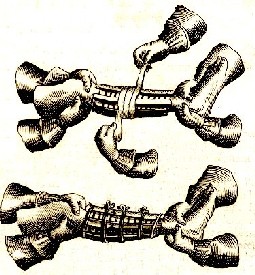
Splints tied with Ligatures, The Chyrurgeons
Storehouse,
by Johannes Scultetus,
taken from
Table 30 ,p. 106 (1653)
that the surgeon "apply the bandages so as to suit the splints, and a little more tight than formerly, unless there be more pain from the swelling in the hand. When you have applied the bandages, you must adjust the splints all around the limb, and secure them with strings so loose as just to keep them in their place, without the application of the splints contributing at all to the compression of the arm."1 He recommended checking and tightening the splints every couple of days, "always keeping in mind that the object of the splints is to maintain the lower bandages in their place, and that they are not needed in order to contribute to compression."2
Richard Wiseman explains how pasteboard splints should be used. He recommends that they be "cut into pieces proportionable to lay over those Splenia ['linen Cloaths folded four times double, and cut in length and breadth like the Ferulæ'] or, having fastned the Splenia by the broad Bandage with three heads, cut a piece of Pastboard fit to receive the lower part of the Member, and leave a place commodious for dressing the Wound. Over the other part of the fractured Member you must place another piece of Pastboard to answer unto the former. These ought to be wet, that they may lie more pliant. About the Pastboard make a Bandage with three Ligatures [fabric ties], which you must fasten in the most convenient place for the ease of the Patient."3
Sea surgeon John Woodall advises newly minted sea surgeons 
Worsted Wool Tape
to "understand [that] I use no rowlers at all, but clowts
[folded fabric to protect the leg from the splints, similar to Wiseman's splenia], splints armed and
tape"4. Tape here does not refer to what we think of today - an adhesive-backed strip of material. Woodall is talking about a flat worsted wool material (without adhesives) which can be tied as seen in the drawing above.
Woodall goes on to explain that he prefers tape because rollers get loose and require re-rolling, which "endangereth much the disjointing of the boanes againe, and causeth paine... nothing cureth a fractured boanes so much as rest: wherefore when a bone is newly placed, and shall be troubled much with lifting and rowling, it cannot but hinder unition"5. William Clowes and John Moyle both advise using tape on splints as well6, suggesting that many period military and sea surgeons preferred it to ligatures.
Finger splints are used slightly differently. Naval surgeon John Atkins explains that he uses "only a Plaister Compresses, and two Splints; Rowling I think inconvenient here, in that it wreaths the Finger aside, and makes a distorted Unition: The middle Part of the Plaster is to be applied on the Wound, and to come round the Finger, (first cutting out so much as may leave room for Dressing). The two small Splints with each a Compress, I place on the upper and under Part... and having tied the whole a couple of narrow Ligatures, place it to the Breast to be out of the way."7
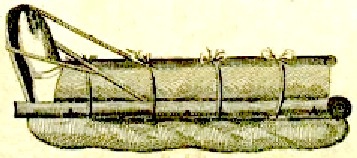
Protecting a leg from splints from A General System of
Surgery
by Lorenz Heister, Plate 38 (1750) A couple surgeons advise caution when using splints. Woodall warns about tying them on properly, noting that "it is a generall fault of divers young Surgeons, for many thinke they have never bound hard enough, and yet too loose is a fault, but easily may bee
amended, and I advise thee to looke to thy patient often, that his splints gall him not, for that bringeth want of rest, and divers evill accidents depending thereupon"8.
John Atkins suggests that "the Continuance in one Posture only will frequently induce a Stiffness and Rigidity in such Joint, and this the more the Patient is in Years; so when we lend a helping Hand, and fix it immoveably, as it were, by Bandage and Splints, we have Reason to fear an Anchilosis [Ankylosis - a stiffness of a joint due to abnormal adhesion and rigidity of the bones of the joint] by it."9
1,2 Hippocrates, Of Fractures, Hippocratic Writings, Translated by Francis Adams, p. 77; 3 Richard Wiseman, Of Wounds, Severall Chirurgicall Treatises, p. 423; 4,5 John Woodall, the surgions mate, p. 161; 6 William Clowes, Selected Writings of William Clowes, p. 128 & John Moyle, The Sea Chirurgeon, p. 118; 7John Atkins, The Navy Surgeon, p. 53; 8 Woodall, p. 165-6; 9 Atkins, p. 44
Bandaging Procedures
Periods surgical authors highlighted several aspects of surgery which they felt were important to effectively bandaging a patient. We will look at three bandaging procedures: 1) Performing the job neatly; 2) Using bandages to manage humors in the body and 3) Using bandages to deal with unusual situations.Bandaging Procedures: Performing with Neatness
"Neatness and a good Grace are necessary, that the Patient, those with him, and the Operator himself, may be pleas’d with his Performance." (Pierre Dionis, A course of chirurgical operations: demonstrated in the royal garden at Paris. 2nd ed., p. 33)
Every author who devotes a particular part of his book to bandaging has something to say about the importance of neatly applying bandages.
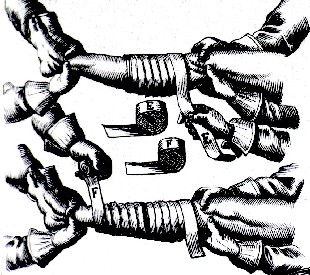
Dressing a leg neatly, from Armamentum Chiurgicum
Bipartitum by Johannes Scultetus, Plate 51 (1666)
Charles Gabriel Le Clerc starts off his book on bandaging by explaining that "Nothing can give a Patient more Satisfaction than to see his Dressings neatly made: This makes him think that he has the good Fortune to fall into the Hands of a skilful Artist, and has nothing more to desire. On the contrary, if the Dressings be slovenly, besides the dangerous Accidents which follow, the Patient is disturbed, vexes and frets; and these Passions are the Cause of a great many other ill Symptoms."1
He adds that while the surgeon's work on a patient is impossible to judge by the average person, "all the World, by casting their Eyes on the Dressings, judge whether they are well or ill made. Thus does the Reputation of a Skilful Person often depend on a Trifle; and it is this which is more necessary for the most part than real Merit."2
With regard to the neatness of a bandaging job, Ambroise Paré explains that a surgeon must consider "whether he hath performed it well and fitly, as also neatly and elegantly, to the satisfaction both of himself and the beholders. For it is the part of a skilfull Workman every where handsomely and rightly to perform that which may so be done."3
1 Charles Gabriel Le Clerc, A Description of Bandages and Dressings, p. 1; 2 Le Clerc, p. 1-2; 3 Ambroise Paré, The Workes of That Famous Chirurgeon Ambroise Parey, p. 358
Bandaging Procedures: Managing the Humors
"You must also be careful that your Bandage be not too hard [tight], so as to intercept the Spirits. Your Rowler running downwards will press out the Matter from the affected Part, and by passing upward hinder the influx of Humours." (Richard Wiseman, Of Wounds, Severall Chirurgicall Treatises, p. 343)
Humors were believed to be fluids that were in the body, as was mentioned on the Page 2 when we discussed blister plasters. When someone received a wound, most medical practitioners during the golden age of piracy thought that the wound either generated or attracted bad humors.
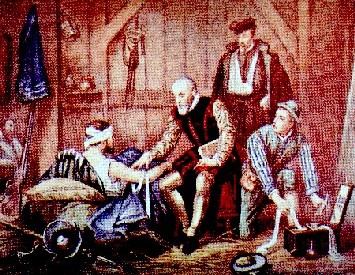
Ambroise Paré Bandaging the Wounded by Eduoard Hamman
Paré recommended 'strait' or tight bandaging "so the set bones may be the better kept in their places, and... the humors, if any be already fallen thither, may by this strait compression be pressed forth of its proper vessles, as those which are violently battered and torn".1 His concern was that wounds would produce "sugillation in the neighbouring flesh, which first looks red, but afterwards black and blue by reason of the corruption of the blood [by the 'bad' humors generated by the wound, which was then] poured forth under the skin."2
Paré felt that the bandage must be wound well above and below the wound, warning that "he which does otherwise, will more and more draw the blood and humors into the affected part, and cause Impostumes [large abscesses], and other malign accidents."3
His next observation gives a rather interesting insight into how humoral theory was believed to work.
Now the blood which flowes, goes but one way downwards, but that which is pressed is carried as it were in two paths, to wit, from above downwards, and from below upwards. Yet you must have a care that you rather drive it back into the body and bowels, [rather than] towards the extremities... [because they] are uncapable of [handling] so much matter, and not furnished with sufficient strength to suffer the burden, which threatens to fall upon it.... But when this masse and burden of humors is thrust back into the body, it is then ruled and kept from doing harm by the strength and benefit of the faculties remaining in the bowels and the native heat.4
Thus, according to Paré, all humors could be naturally dealt with by 'the native heat' created in the center of the body and the 'cleansed' fluids could be sent back out. While it isn't what Paré was describing, this concept is remarkably similar to
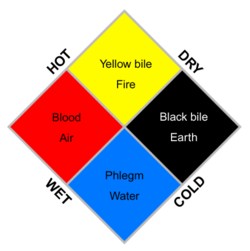
The Four Humors
the way blood delivers oxygen to the body's cells, returning to the lungs to be re-oxygenated - a concept that would not be fully grasped until almost 300 years after Paré's death.
While 'strait' wrapping was important to chasing the humors away from a wound, the surgeon had to be cautious not to bandage too tightly. Paré warns that "the humors by too strait binding are pressed into the extreme parts of the body; whence grievous and oft-times enormous Oedema's [fluid retention in the cells] proceed; for healing whereof the Ligature must be loosed, and then the tumified [swollen] parts pressed by a new rowling, which must be performed from below upwards, and so... forcing the matter of the tumor thither [back into the center of the body"5.
Paré explains that even the great Hippocrates "bids that the bandages be loosed every three dayes, and then to foment the part with hot water, that so the humors, which (drawne thither by the vehemency of pain) have setled in the part, may be dissolved and dispersed"6. Here again, Paré suggests heat will dissipate the formation of bad humors. It is also interesting that he thought that pain attracted the undesirable humors.
1 Ambroise Paré, The Workes of That Famous Chirurgeon Ambroise Parey, p. 358; 2,3,4 Ibid; 5,6 Paré, p. 359
Bandaging Procedures: Dressing the Unusual
While fractures, luxations and wounds all required bandaging, Ambroise Paré discusses some other curious uses for bandages which a worth sharing.
The first is to keep wounded skin from growing together
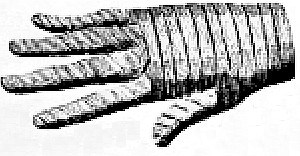
Hand Dressing from A General System of
Surgery
by Lorenz Heister, Plate 28 (1750)
where it should not. Paré explains that the bandages prevent this in wounds such as "Burns, wherein the fingers and hams would mutually grow together; as also the Arm-pits to the Chest, the Chin to the Breast, unlesse they be hindred by due ligation [application of roller bandages]."1
Several authors mention this problem of burned fingers growing together.2 Given that one of the tortures pirates used to make a captive surgeon reveal the location of hidden treasure was to place "lighted fuses between his fingers,"3 this may have been something useful for a surgeon captured by pirates to know.
Another unusual use for bandages that Paré discusses is driving nutrients from one part of the body to another. This is actually sort of an extension of humoral theory, suggesting that humors could be forced to flow in the direction desired by the surgeon. He explains that bandaging could be used "to refresh emaciated parts: wherefore if the right leg wast[e] for want of nourishment, the left leg, beginning at the foot, may be conveniently rowled up even to the groin. If the right arm consume, bind the left with a strait [tight] Ligature [wrapped bandage], beginning at the hand, and ending at the arm-pit. For thus a great portion of blood from the bound-up part is sent back into the vena cava, from whence it regurgitates into the almost empty vessels of the emaciated part."4 Paré does warn not to bind the part so tightly "that thereby it becomes not painfull; for a dolorifick ligation [painful binding] causes greater attractation of blood and spirits"5, which again points to the humoral theory.
Paré leaves us with one last interesting use for bandages during amputation. He advises the "triple use of Ligatures
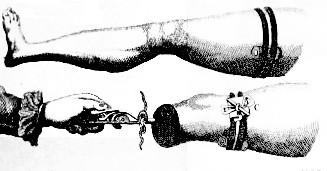
Ligatures in Amputation from A General System of Surgery
by Lorenz Heister, Plate 14 (1750)
in amputation of members, as arms and legs. The first to draw and hold upwards the skin and muscles lying under it, that the operation being performed; they may, by their falling down again [after being released], cover the ends of the cut-off bones; and so by that means help forward the agglutination [healing together of the skin] and cicatrisation [formation of a scar]; and when it is healed up, cause the lame member to move more freely, and with lesse pain; and also to performe the former actions, this, as it were, [will] cushion or boulster of musculous flesh lying thereunder. The second is, they hinder the bleeding by pressing together the veins and arteries. The third is, they by strait [tight] binding intercept the free passage of the animall spirits, and so deprive the part which lyes thereunder of the sense of feeling, by making it, as it were, stupid or num."6 Awfully handy things during an amputation are those bandages!
1 Ambroise Paré, The Workes of That Famous Chirurgeon Ambroise Parey, p. 360; 2 See for example John Atkins, The Navy Surgeon, p. 246 & Richard Wiseman, Of Wounds, Severall Chirurgicall Treatises, p. 343 & 442; 3 Eric J. Graham, Seawolves: Pirates & the Scots, p. 109; 4,5,6 Paré, p. 360

